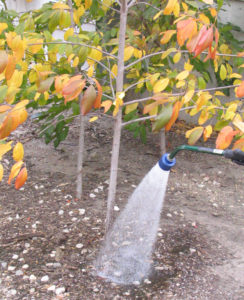 During the dormant season, plants don’t seem to tell us much about how thirsty they are. Grass doesn’t look overly stressed, leaves don’t appear wilted and because we are inside more, we tend not to be thinking so much about plants being thirsty.
During the dormant season, plants don’t seem to tell us much about how thirsty they are. Grass doesn’t look overly stressed, leaves don’t appear wilted and because we are inside more, we tend not to be thinking so much about plants being thirsty.
In the next growing season, plants can and will show the effects of winter drought stress. Plants can suffer root loss due to dehydration during winter and spring. And next season, there are fewer roots to move water to thirsty leaves. The delayed result we see is often leaf scorch.
This is why winter watering matters!
Yes, this is a message you’ve read before, but the longer warm, dry weather continues, the thirstier our plants become. Use the warm weekend ahead to water your plants.
Here’s your checklist:
WHEN
Water anytime daytime temps are above freezing and the soil is not frozen
WHAT
- New trees, shrubs or perennials planted this season. If you have not already watered them, they are likely parched. If you did water during the fall, keep checking soil moisture and water when it is dry.
- More mature plants. Any plants, if soil is dry to a 3-inch depth, need water.
HOW
- Drag out the hose and sprinkler and water the lawn. Be sure to water areas in high sun exposure which tend to suffer winter kill. Water long enough so that the soil is thoroughly soaked without run-off. Water sloped areas shorter periods, but more than once so water soaks in without running off.
- Trees and shrubs are watered most effectively with a hose and a deep-root watering device attached. Because you insert it well into the soil, you will get more water into the root zone than by simply watering the surface of the soil. Water in a circle that corresponds to the area on the ground where the tree branches end. Place the device at 12-18-inch intervals (based on circumference of the tree) as you water.
WHO
If you aren’t able to water your landscape, hire a landscape pro to do the work for you. It’s a good investment in the long-term value of your property.
Hold on to that moisture
Adding a good wood mulch around bases of trees and other plants can conserve as much as 30% of moisture in the soil. It will also help insulate plants against severe cold and fluctuating temps. Important tip: make sure mulch is not placed right next to tree trunks and stems of shrubs. This can hold too much moisture and rot the plant.
To schedule a consultation to see how Designscapes Colorado can help make your yard your personal oasis, call (303) 721-9003, or email us at info@designscapes.org
